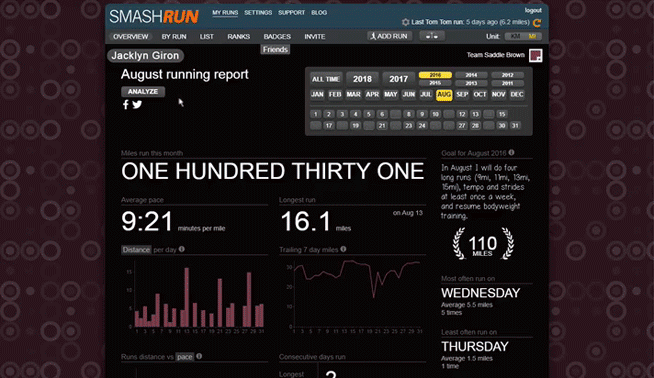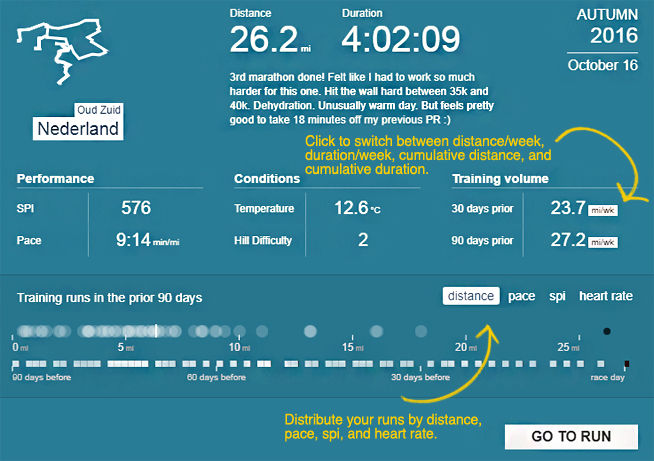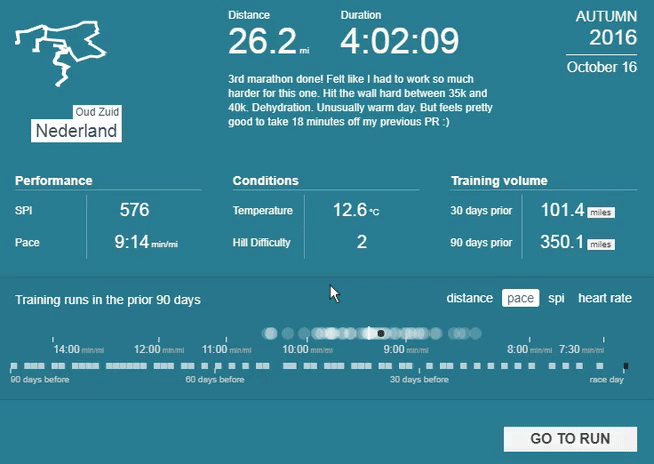An important part of successful race preparation is understanding what worked in the past, what didn’t, and what can be improved. A great way to do that is to use the Analyze Run View to learn from specific races, in combination with your stats dashboard.
Experienced runners generally require between 12-16 weeks of preparation before a half or a marathon. 5k plans are usually shorter (9-12 weeks) and some marathon training plans go as long as 20-30 weeks. This means that the trailing 90-days before a race can provide a wide variety of perspectives into your training.
A quick refresher on the Analyze Run View.
To load the Analyze Run View, click the analyze button, and click on a recent race or best performing run. You can also access it by clicking on any of your PR’s within PR Progress.

The Analyze Run View is broken down into performance, conditions, training volume, and training runs in the past 90 days. The values you might expect and the distribution of your runs will vary depending on the run you’re viewing. Here’s how it works.

Remember that you can highlight the runs themselves and you can go to the run, by clicking on its matching white box on the time scale. The cool thing about this is that you can see when you ran your long runs or, if you’re viewing your pace distribution, when you did most of your speedwork.

Here’s how you make the most of your analysis.
When evaluating your training, only compare runs of similar distance and conditions. Looking at weeks of speedwork dedicated to improving a fast 5k probably won’t teach you the best way to race a half. And different race distances require different analysis.
- When you look at a marathon, consider your training volume (average distance/week or duration/week). Visualize runs by distance – what was the longest run you did prior to your race/tune-up and what percentage of your runs were long? You can even see how much of your trailing 90-days were in your aerobic vs. anaerobic zone – just filter your training runs by pace and/or heart rate.
- For shorter races, it might be more useful to look at a distribution of your average pace or SPI. Race-specific training for a 5k or 10k tends to have more tempos, intervals, and time trials, which makes pace a good measure of how you’re progressing.
Additionally, since the Analyze Run View relies on the trailing 90 days leading up to a run, training gaps and tapering will average down your training volume and you could inadvertently exclude parts of the peak of your training.
To exclude the taper prior to a marathon or half, do a *tune-up run, or race a shorter event than your target distance. A tune-up is often 4-6 weeks out before race day, and runners usually limit their taper before a tune-up. As a result, the trailing 90 days leading up to it is a better representation of your training.
We don’t always take the time to look back over our training after we’ve run the race, but the best lessons come from previous experience. When we’re aiming for a PR, it’s nice to have something like the Analyze Run View to learn from our best runs and, with a tune-up, it’s an ideal way to measure our progress to see if we’re on target.
*If you need some ideas for adding a tune-up to your training schedule, RunnersConnect has a great blog post on how to incorporate tune-up races into your training.

This really is insanely cool! I am getting over a slump after running for 400 days from the start of 2017 then having a fall. I need this motivation!